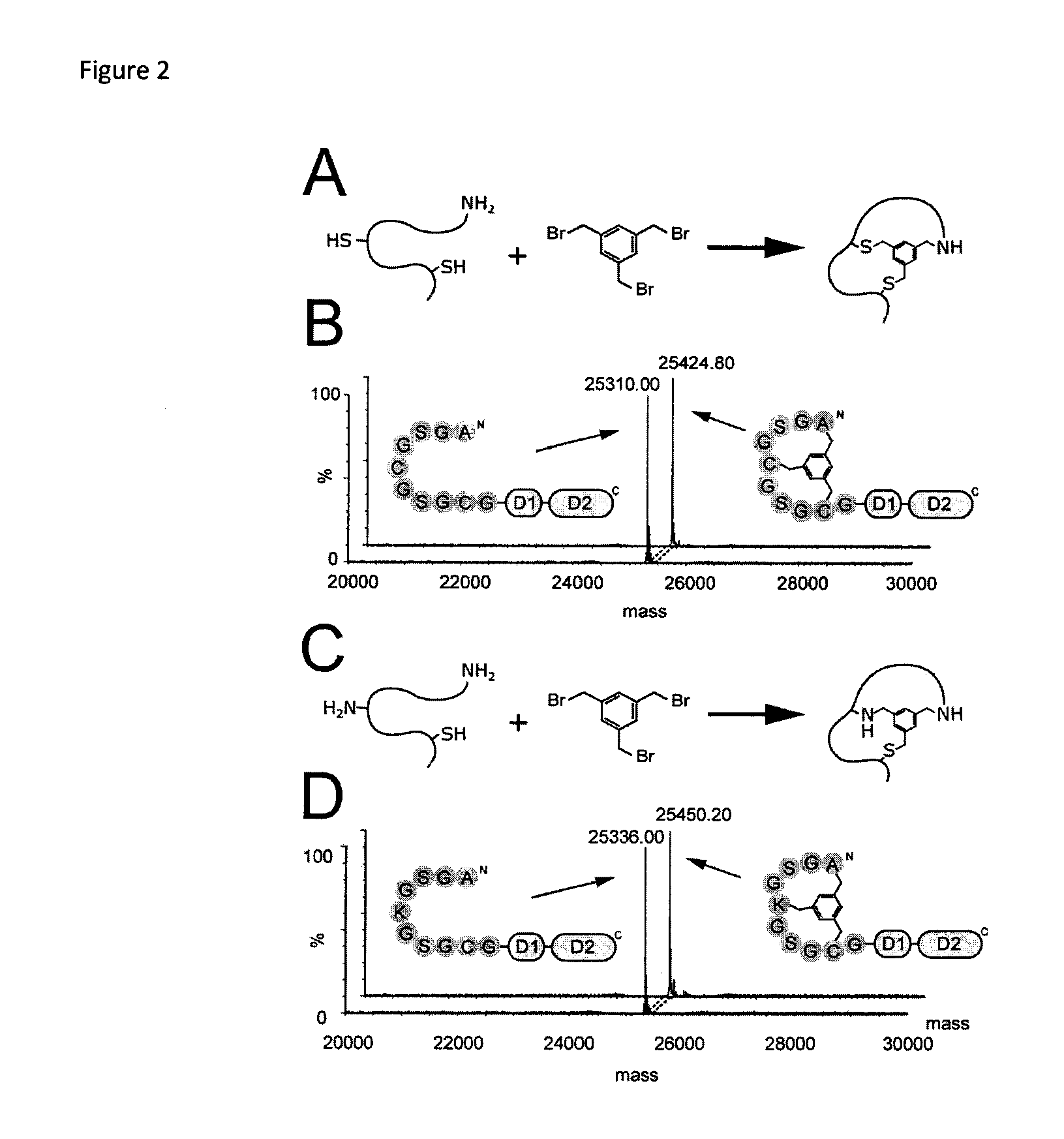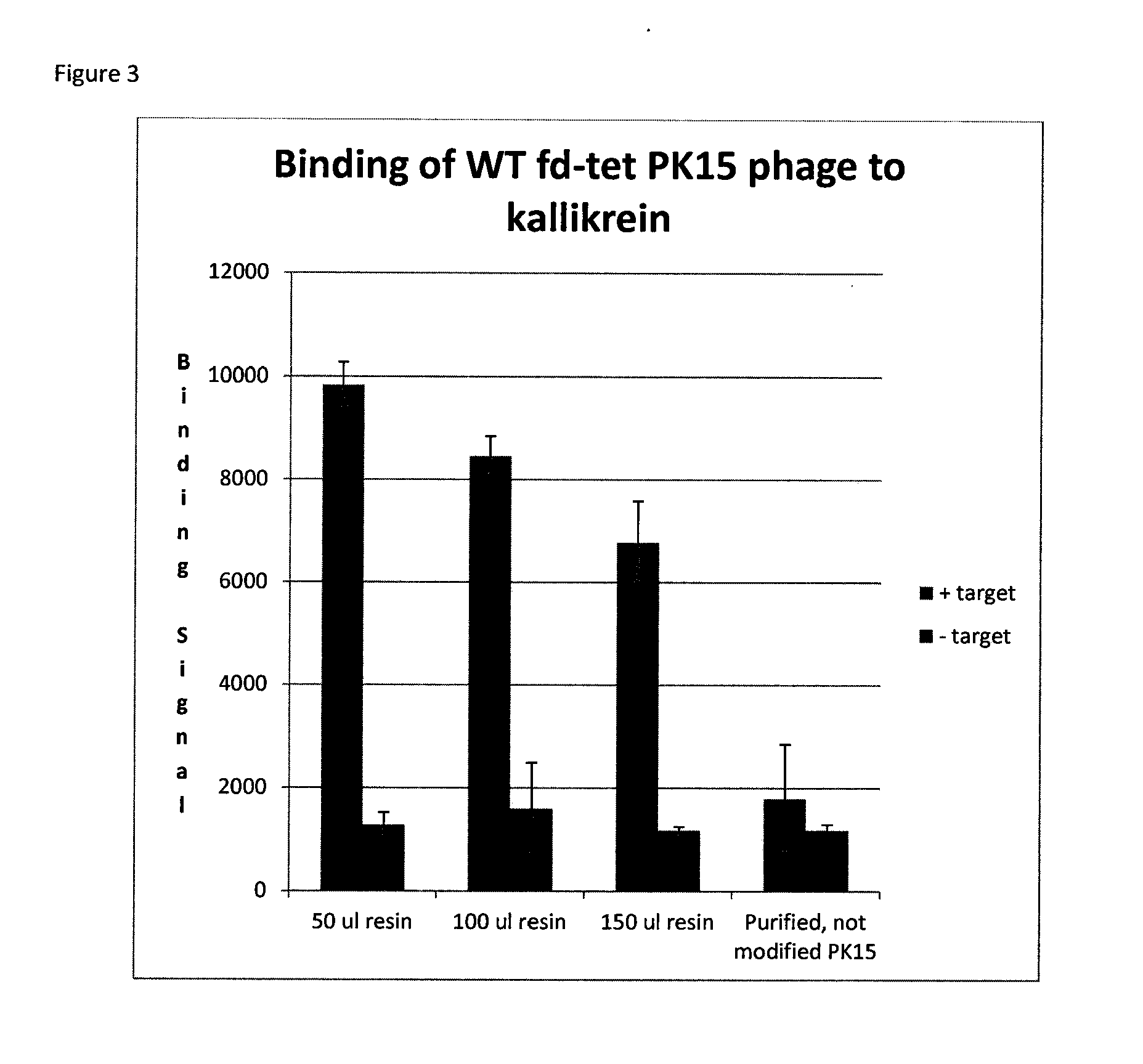Modification of polypeptides
- Summary
- Abstract
- Description
- Claims
- Application Information
AI Technical Summary
Benefits of technology
Problems solved by technology
Method used
Image
Examples
example 2
Modification of Phage on Resin
[0222]PK15 is a three cysteines containing peptide (H-ACSDRFRNCPADEALCG-NH2), which when coupled with TBMB, is a specific and potent inhibitor of human plasma kallikrein. This peptide can be displayed as a fusion to gene 3 protein of phage and if correctly modified by TBMB will result in a phage that can specifically bind to kallikrein. Non-modification of PK15 on the phage or cross-linking of the phage would not result in a specific binding signal for the phage binding to kallikrein.
[0223]Anion exchange resin was used to capture the phage, allowing for quick and easy changing of the buffers that the phage were exposed to during the modification process. The phage were also titred for particle number and infectivity to show that the modification process had not made the phage significantly less infectious.
Materials and Methods
[0224]1. 1 ml of 1M NaHCO3 was added to either 50 μl, 100 μl or 150 μl of an approximately 50% slurry of a strong anion exchange ...
example 3
Polypeptide Modification on Phage Using Magnetic Separation
[0240]The use of a magnetic separation station for the isolation of phage displaying polypeptides is described. In addition, in the present example, the effect of:[0241]Different binding buffers (i.e. phage input solution)[0242]Different binding / wash buffers (i.e. buffer during modification)[0243]Different elution buffers
on the efficiency and yield of the magnetic TCEP / TBMB modification process is reviewed. The polypeptide used was PK15, displayed on wild-type FdTet.
Materials and Methods
[0244]A colony from E. coli containing PK15 / WT FdTet which had been freshly streaked on an agar plate was used to inoculate 25 ml of either 2TY / tet or LB / tet, and cultures were incubated overnight at 37 C shaking 250 rpm.
[0245]The following solutions were prepared:
Elution Buffers:
[0246]Citrate solution=100 mM (2×)→pH2.0 (without adjustment)
[0247]20 ml portions of the 100 mM citrate buffer were diluted 1-in-2 with water, then pH-adjusted (with...
example 4
Comparison of ‘Quick’ and ‘Long’ Magnetic Phage Modification Protocols
[0296]The phage modification process has been optimised from a ‘long’ protocol. The results of the long protocol are compared herein to a shortened protocol.
[0297]A colony from streaked PK15 / WT FdTet plate as in Example 3 was used to inoculate 25 ml of 2TY / tet. The culture incubated overnight at 37° C., shaking at 250 rpm.
[0298]Long and quick protocols were performed. These are illustrated in FIG. 6.
[0299]The quick protocol is as follows[0300]Rinse 20 μl magnetic ion exchange beads in 1 ml 1M NaHCO3 buffer and resuspend in 10 μl of the same buffer.[0301]A. 1 ml input solution (Culture / beads / TCEP), mix for 20 minutes and capture the beads magnetically.[0302]B. Wash the beads in 1 ml NaHCO3 / EDTA buffer+1 μM TCEP by mixing the beads with the buffer and immediately recapturing the beads magnetically[0303]C. Mix the beads in NaHCO3 / EDTA buffer+(TBMB in ACN)[0304]where [ACN]final=20%; [TBMB]final=60 μM for 10 minutes be...
PUM
| Property | Measurement | Unit |
|---|---|---|
| Temperature | aaaaa | aaaaa |
| Magnetism | aaaaa | aaaaa |
Abstract
Description
Claims
Application Information
 Login to View More
Login to View More - R&D
- Intellectual Property
- Life Sciences
- Materials
- Tech Scout
- Unparalleled Data Quality
- Higher Quality Content
- 60% Fewer Hallucinations
Browse by: Latest US Patents, China's latest patents, Technical Efficacy Thesaurus, Application Domain, Technology Topic, Popular Technical Reports.
© 2025 PatSnap. All rights reserved.Legal|Privacy policy|Modern Slavery Act Transparency Statement|Sitemap|About US| Contact US: help@patsnap.com



